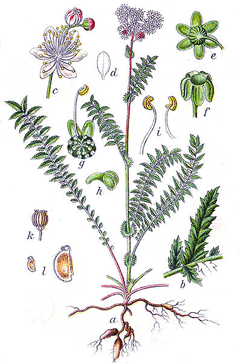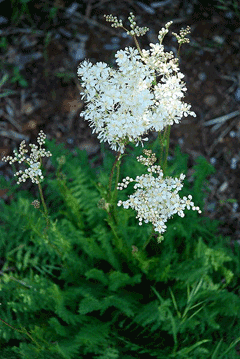 |
|
http://commons.wikimedia.org/wiki/File:Filipendula_vulgaris_Sturm134.jpg |
 |
| http://commons.wikimedia.org/wiki/User:Paul_Hermans |
Translate this page:
Summary
Bloom Color: White. Main Bloom Time: Mid summer. Form: Upright or erect.
Physical Characteristics

 Filipendula vulgaris is a PERENNIAL growing to 0.8 m (2ft 7in) by 0.4 m (1ft 4in) at a medium rate.
Filipendula vulgaris is a PERENNIAL growing to 0.8 m (2ft 7in) by 0.4 m (1ft 4in) at a medium rate.
See above for USDA hardiness. It is hardy to UK zone 3 and is not frost tender. It is in flower from May to August, and the seeds ripen from July to September. The species is hermaphrodite (has both male and female organs) and is pollinated by Bees, flies, beetles. The plant is self-fertile.
It is noted for attracting wildlife.
Suitable for: light (sandy), medium (loamy) and heavy (clay) soils, prefers well-drained soil and can grow in heavy clay soil. Suitable pH: neutral and basic (mildly alkaline) soils and can grow in very alkaline soils.
It cannot grow in the shade. It prefers dry or moist soil.
UK Hardiness Map
US Hardiness Map
Synonyms
F. hexapetala. Spiraea filipendula. Ulmaria filipendula.
Plant Habitats
Ground Cover; Meadow;
Edible Uses
Edible Parts: Leaves Root
Edible Uses:
Young leaves - raw or cooked[61, 177, 200]. They can be added to salads and soups[183]. Root - raw or cooked[61, 115, 177, 200]. Rather bitter[5]. Astringent[100]. Best if roasted[141]. A famine food, it is only used in times of scarcity[183].
References More on Edible Uses
Medicinal Uses
Plants For A Future can not take any responsibility for any adverse effects from the use of plants. Always seek advice from a professional before using a plant medicinally.
Anthelmintic Antispasmodic Epilepsy Lithontripic
The root is anthelmintic and lithontripic. It is used in the treatment of epilepsy, kidney and bladder stones, genital discharges and intestinal worms[61].
References More on Medicinal Uses
The Bookshop: Edible Plant Books
Our Latest books on Perennial Plants For Food Forests and Permaculture Gardens in paperback or digital formats.

Edible Tropical Plants
Food Forest Plants for Hotter Conditions: 250+ Plants For Tropical Food Forests & Permaculture Gardens.
More

Edible Temperate Plants
Plants for Your Food Forest: 500 Plants for Temperate Food Forests & Permaculture Gardens.
More

More Books
PFAF have eight books available in paperback and digital formats. Browse the shop for more information.
Shop Now
Other Uses
Plants can be used as a ground cover when planted about 45cm apart each way[208]. The cultivar 'Flore Pleno' with sweetly scented double flowers has been recommended[208].
Special Uses
Attracts Wildlife Ground cover Scented Plants
References More on Other Uses
Cultivation details
Landscape Uses:Massing, Rock garden. Prefers a well-drained moisture retentive soil[200]. Dislikes shade[17]. Tolerates dry soils[200]. Grows well on calcareous soils[17]. The flowers are sweetly scented and are very attractive to bees[245]. Members of this genus are rarely if ever troubled by browsing deer[233]. Special Features:
Attractive foliage, Naturalizing, Suitable for cut flowers.
References Carbon Farming Information and Carbon Sequestration Information
Temperature Converter
Type a value in the Celsius field to convert the value to Fahrenheit:
Fahrenheit:
The PFAF Bookshop
Plants For A Future have a number of books available in paperback and digital form. Book titles include Edible Plants, Edible Perennials, Edible Trees,Edible Shrubs, Woodland Gardening, and Temperate Food Forest Plants. Our new book is Food Forest Plants For Hotter Conditions (Tropical and Sub-Tropical).
Shop Now
Plant Propagation
Seed - best sown in the autumn in a cold frame[1]. The seed can also be sown in a cold frame in spring, germinating best at a temperature of 10 - 13°c[200]. When they are large enough to handle, prick the seedlings out into individual pots and plant them out in the summer if they have grown enough. If not, keep them in a cold frame for the winter and plant them out in late spring. Division in autumn or winter[200]. Very easy, larger clumps can be replanted direct into their permanent positions, though it is best to pot up smaller clumps and grow them on in a cold frame until they are rooting well. Plant them out in the spring.
Other Names
If available other names are mentioned here
Native Range
TEMPERATE ASIA: Iran, Turkey, Armenia, Azerbaijan, Georgia, Russian Federation (Altay, Sverdlovsk) EUROPE: Denmark, United Kingdom, Norway, Sweden, Czech Republic, Germany, Hungary, Netherlands, Poland, Slovakia, Belarus, Estonia, Lithuania, Latvia, Moldova, Russian Federation (Orenburg), Ukraine, Albania, Bulgaria, Greece, Italy, North Macedonia, Montenegro, Romania, Serbia, Slovenia, Spain (Baleares), France, Portugal AFRICA: Morocco
Weed Potential
Right plant wrong place. We are currently updating this section.
Please note that a plant may be invasive in one area but may not in your area so it's worth checking.
Conservation Status
IUCN Red List of Threatened Plants Status :

Growth: S = slow M = medium F = fast. Soil: L = light (sandy) M = medium H = heavy (clay). pH: A = acid N = neutral B = basic (alkaline). Shade: F = full shade S = semi-shade N = no shade. Moisture: D = dry M = Moist We = wet Wa = water.
Now available:
Food Forest Plants for Mediterranean Conditions
350+ Perennial Plants For Mediterranean and Drier Food Forests and Permaculture Gardens.
[Paperback and eBook]
This is the third in Plants For A Future's series of plant guides for food forests tailored to
specific climate zones. Following volumes on temperate and tropical ecosystems, this book focuses
on species suited to Mediterranean conditions—regions with hot, dry summers and cool, wet winters,
often facing the added challenge of climate change.
Read More
Expert comment
Author
Moench.
Botanical References
17200
Links / References
For a list of references used on this page please go here
Readers comment
| Add a comment |
|
If you have important information about this plant that may help other users please add a comment or link below. Only comments or links that are felt to be directly relevant to a plant will be included. If you think a comment/link or information contained on this page is inaccurate or misleading we would welcome your feedback at [email protected]. If you have questions about a plant please use the Forum on this website as we do not have the resources to answer questions ourselves.
* Please note: the comments by website users are not necessarily those held by PFAF and may give misleading or inaccurate information.
To leave a comment please Register or login here All comments need to be approved so will not appear immediately.
|
Subject : Filipendula vulgaris
|
|
|
|